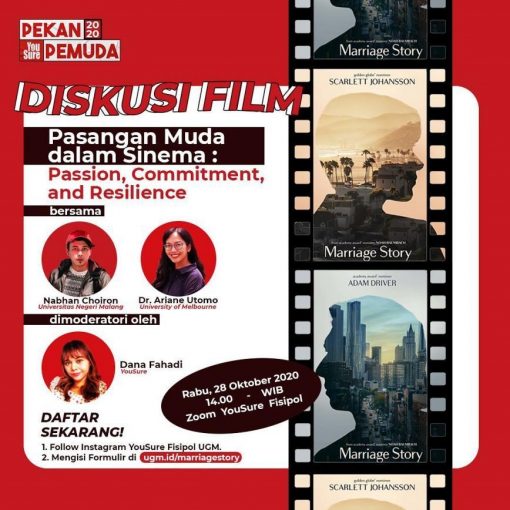
Yogyakarta, October 28th 2020—Analyzing the Marriage Story movie, this film discussion is held in the form of a webinar by inviting the co-author of the article “Who Marries Whom On Silver Screen?Religion And Social Class In Marriage Patterns In Contemporary Indonesian Films”, Nabhan Choiron, as well as the co-editor of Youth Study Journal Marriage Special Edition, Dr. Ariane Utomo. Guided by Dana Fahadi from YouSure, this discussion started by delving more into youth’s struggle to maintain relationships by seeing the Marriage Story movie.
To celebrate Youth Week 2020 “ 2020’s Youth: Reflexivity, Relations, and Social Change”, YouSure Fisipol UGM held a film discussion on “Young Couples in Cinema: Passion, Commitment, and Resilience” in their line of events.
Marriage Story (2019) is a Netflix original production starred by Scarlett Johansson and Adam Driver. This movie pictures an American young couple who is in the middle of a divorce. This movie talks about conflict, dynamics, and other issues that contribute to a modern young couple love journey. Through this film, the speakers try to see the relationship dynamics inside of it, how it fits into the Indonesian context, as well as responding to the anxieties and experience that youngsters have in their relationship.
The discussion started with a brief speech from the moderator about the movie and an introduction to the speakers. Besides the two main speakers, this discussion also has another speaker which was Evi Eliyanah. For starters, Dana asked the speakers about what they felt when watching the movie. Nubhan replied to Dana’s question from the perspective of someone who has never been married. He felt worried and anxious about whether marriage life is really like the one shown in Marriage Story. Nubhan also sees that America and Indonesia have a similar socio-cultural condition. The two states have a lot of provinces as well as a religion that dominates. Therefore, marriage and divorce is still seen as a complex problem.
Meanwhile, through this movie, Ariane got the message that not all love stories are like the story of Cinderella. She also said that the condition is similar to that in Indonesia. For example, couples meet in the same community and ecosystem, small families that live far from big families, and the increase of divorce rates, especially after reformation.
Moreover, Ariane saw a shift in society’s perspective about divorce as an interesting phenomenon, because the rise of divorce not only happens in young couples, but also in old couples. She sees that in the divorce phenomena, there is a political context inside of it. A lot of factors contributes to social change that eventually affects marriage and divorce dynamics.
Dana then asked the speakers about how a movie can change the values in a society. Evi said that a movie is produced, consumed, and distributed by people that have a certain perspective and experience. Therefore, a movie is never divorced from political motives. This personal experience is then received by watchers. However, watchers or viewers don’t just accept everything in the movie without a process. Viewers negotiate between what they want to take from the movie based on their own personal experience. Evi said that a movie is a medium for the creator and glasses for the viewers.
Moreover, Dana asked the speakers to talk about how the Marriage Story movie shows the relation of contemporary couples, the marriage trend in the middle of the pandemic, as well as recommendations of Indonesia movies on marriage. Throughout the discussion, the dialog was done interactively between speakers. Not only that, at the end of the event, the discussion also involved the attendees in the question and answer session. After responding to the commentaries and questions by the attendees, the speakers are then allowed to give a closing statement. The discussion then officially ended after questions about the Mudik movie was answered by the speakers.
